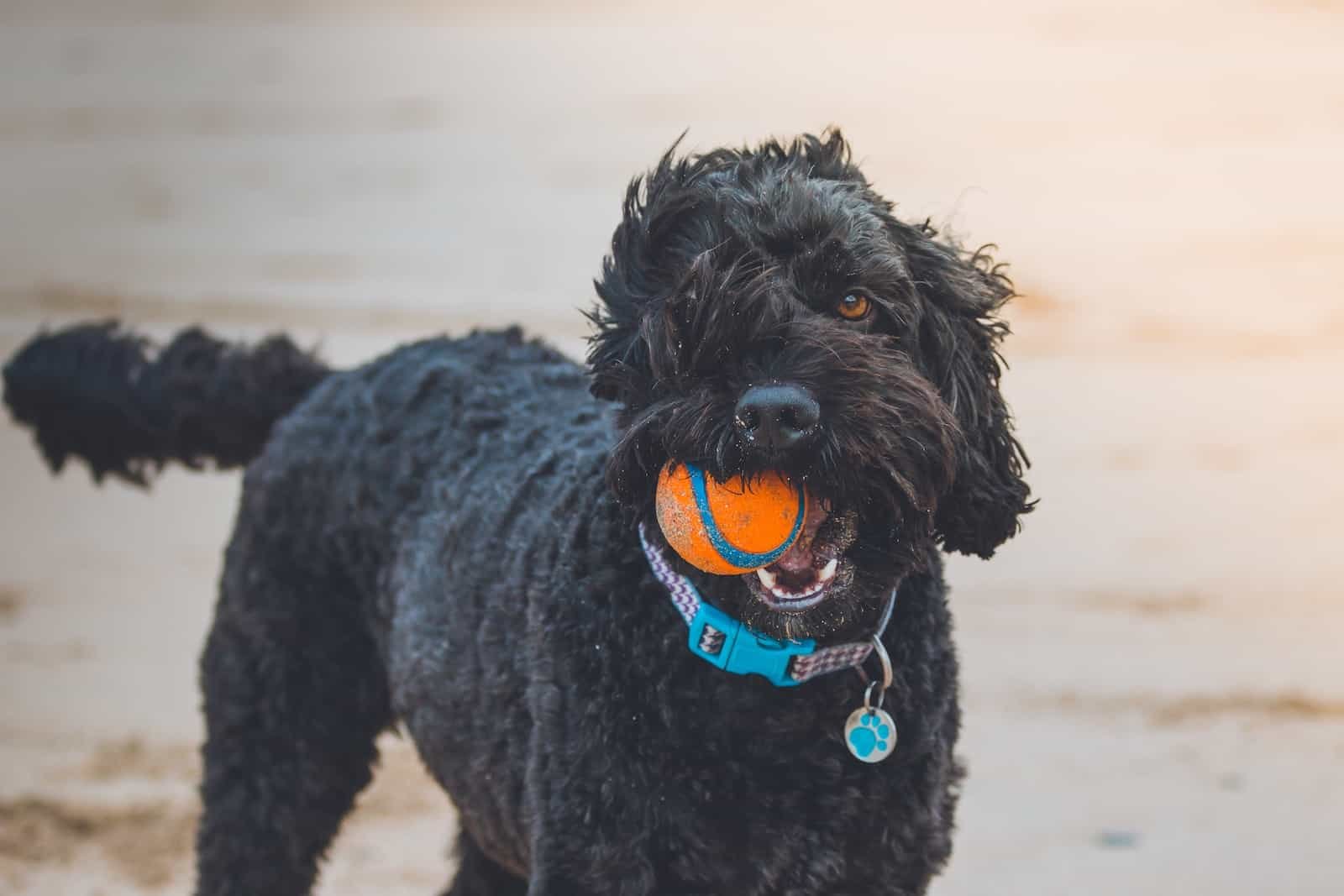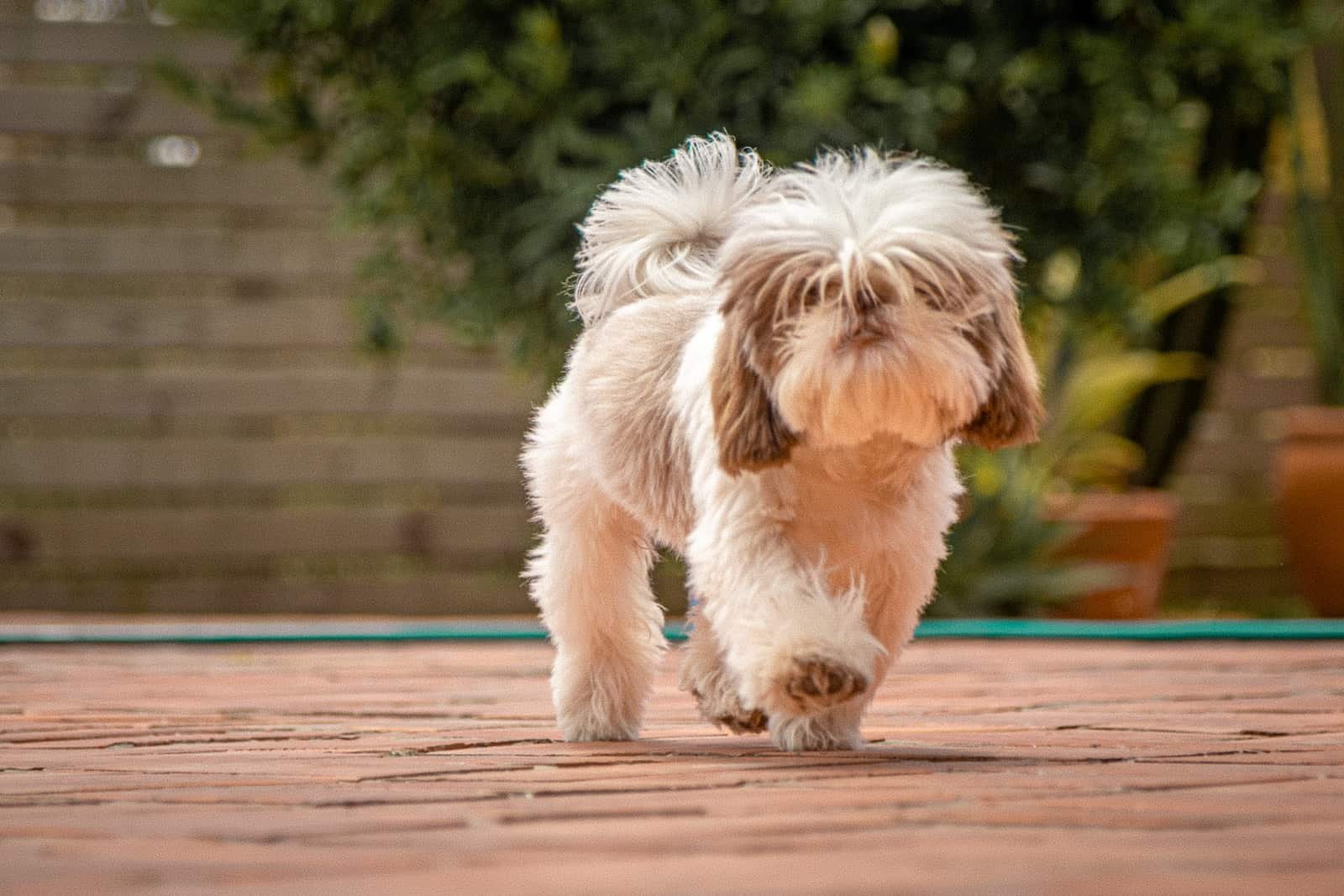
Are you looking for a loyal companion who is smart and full of energy? Meet the Shepadoodle–the German Shepherd-Poodle mix that makes the perfect pet! This amazing breed has been gaining attention in recent years, and it’s easy to see why. Not only are they friendly and protective, but they are also incredibly intelligent and enjoy mental stimulation. Keep reading to learn more about this unique hybrid breed and all of its advantages!
What is a Shepadoodle?
The Shepadoodle is a unique designer breed that combines the intelligence of the German Shepherd with the loyalty and hypoallergenic coat of a Standard Poodle. These dogs are usually larger, reaching anywhere from 14 to 24 inches tall when fully grown. They have curly coats that come in a variety of colors, and their energy levels make them an excellent choice for outdoor activities like agility training. Shepadoodles are also known for being excellent watchdogs, but they need plenty of exercise to prevent destructive behaviors. With proper care and attention, these intelligent breeds can be loyal companions for many years.
Conclusion
The Shepadoodle is an impressive hybrid breed that has quickly become popular among pet owners looking for an intelligent companion dog with a lot of energy. They are friendly and protective while still being hypoallergenic, making them ideal for homes with allergies. Although they need daily exercise and lots of mental stimulation, these designer dogs make excellent family pets if given the right care. If you’re looking for a loyal companion with an endearing personality, then consider bringing home your very own Shepadoodle today!
The Shepadoodle is a perfect companion for those looking for an intelligent and loyal friend to share their home with. With the right care and attention, these dogs can be lifelong members of the family. So if you’re ready to make a difference in someone’s life, why not consider bringing home a Shepadoodle today? And don’t forget – there are many advantages to owning a Shepadoodle that will make them even more rewarding!
Advantages of Shepadoodles
Shepadoodles offer a unique combination of intelligence and loyalty, making them an excellent companion for both families and individuals. Because of their hybrid nature, they have fewer genetic health issues than either parent breed. They are also relatively low maintenance for grooming, with their curly coats only needing brushing a few times a week to keep them clean and healthy. Shepadoodles also have good temperaments, being friendly with people and other animals while still displaying protective tendencies as watchdogs. With enough exercise and mental stimulation, these dogs can be content indoors or outdoors, making them ideal for those with limited outdoor space. All in all, Shepadoodles make wonderful family pets if given the proper care and attention!
History
Shepadoodles have been around since the late 1990s, when they were first bred in Australia. This designer breed is created by crossing a German Shepherd with a Standard Poodle to create an intelligent and loyal hybrid. Since then, Shepadoodles have become popular all over the world, with more people recognizing their many benefits. They are excellent watchdogs and make great family pets because of their friendly nature and low grooming requirements. Additionally, shepadoodles are known for being energetic and needing plenty of exercise, making them ideal for active households or families who enjoy outdoor activities. With its intelligence, loyalty and good temperament, it’s no wonder why this designer breed has become so popular in recent years!
The Shepadoodle is the perfect companion for families who want a loyal and intelligent pet. And with its highly sought-after qualities, it’s no wonder why this designer breed is becoming increasingly popular! But what about the parent breeds that make up this hybrid? Find out more in our next section…
Parent Breeds
The Shepadoodle is a hybrid dog created by crossing a German Shepherd and a Standard Poodle. Although both breeds have unique characteristics, they come together to make this beautiful and intelligent designer breed.
The German Shepherd is one of the most popular breeds in the world, known for its intelligence, loyalty and protective nature. They are larger dogs that can range from 24-26 inches tall and weigh up to 90 pounds. German Shepherds were originally bred for herding purposes, but today they are used for many jobs such as search and rescue, guarding and agility competitions.
Standard Poodles are also highly intelligent dogs that love mental stimulation and thrive on physical activities such as agility training. They have curly coats that require regular grooming to maintain their appearance and come in three sizes – toy, miniature or standard. The standard size can reach 15 inches tall at the shoulder with an average weight of 40-70 pounds.
With two such intelligent parent breeds, it’s no wonder why the Shepadoodle has become a popular choice for families looking for an active companion pet!
Development of the Shepadoodle Breed
The Shepadoodle is a relatively new designer breed that has become popular among owners looking for an intelligent and loyal companion pet. This hybrid was developed by crossing a German Shepherd with a Standard Poodle, combining the intelligence of both breeds to create something special.
Since its inception, the Shepadoodle has been bred for its intelligence, loyalty, and protective nature. While it is not recognized by any formal breed registry, the Shepadoodle has gained immense popularity in recent years because of its loving personality and low-shedding coat.
Shepadoodles come in three sizes — mini, standard, and toy — all of which can reach up to two feet in height and weigh anywhere from 15 to 90 pounds. These beautiful dogs have coats that may be wavy and can be black, white, brown, or tan.
For exercise needs, the Shepadoodle requires plenty of daily activity, such as long walks or hikes and lots of playtime outdoors. Without enough physical stimulation, they may resort to destructive behaviors such as chewing on furniture or barking excessively. They also need lots of mental stimulation through activities like agility training or obedience classes to keep their energy levels in check.
Overall, this hybrid breed is perfect for those looking for an intelligent and devoted companion who will thrive with lots of exercise and attention!
Reputable Breeder Considerations
When looking for a Shepadoodle, it is important to ensure that you are getting your pup from a reputable breeder. Reputable breeders will provide health clearances and history on the parent breeds, including genetic diseases such as hip dysplasia. They should also be knowledgeable about the breed and willing to answer questions you may have.
It is best to avoid pet stores or puppy mills when searching for a Shepadoodle, as these places rarely take proper care of their animals or put them through rigorous testing prior to adoption. Visiting the breeder in person and seeing the environment first-hand is always recommended, if possible. It is also important to ask for references from other customers who have purchased from the same breeder before.
Lastly, make sure that all paperwork regarding the puppy’s health and pedigree are provided at the time of purchase. Doing your research beforehand can save you a lot of time and money in the long run, so make sure you ask plenty of questions before committing to buying a Shepadoodle!
Formal Breed Registration
Formal breed registration is an important part of owning a Shepadoodle and one that should not be taken lightly. All puppies must have valid papers proving their parentage and breed in order to be registered with the American Kennel Club or other recognized breed organizations. The process typically involves providing the breeder with proof of pedigree, health clearances, and other relevant documents for both parents. Once accepted, the puppy will then receive its own papers that certify their lineage.
Having formal registration papers ensures that your Shepadoodle is a purebred, which may affect insurance coverage and future breeding plans. It also gives you access to various resources such as obedience classes, agility competitions, and more, depending on the organization you choose to register with. Lastly, registering your pup allows it to take part in conformation shows if desired.
Appearance
Shepadoodles are an intelligent crossbreed between a German Shepherd and a Standard Poodle. They have the loyalty and protective nature of the German Shepherd, along with the intelligence, agility, and curly coat of the standard poodle. As a result, shepadoodles can reach between 22-28 inches tall when fully grown and weigh anywhere from 50 to 80 pounds depending on their parentage.
Their coats come in a variety of colors, such as black, white, brown, cream, sable and more. They may also have markings like those seen on their parents’ breeds or be completely solid. Their coats are usually soft and silky, with curls that range from loose waves to tight ringlets. Shedding is typically minimal with this breed because of its poodle heritage, but brushing is still recommended to keep it looking its best!
Shepadoodles make wonderful family companions because of their intelligence, loyalty and protective nature, as well as their low-maintenance coat. Find out more about this amazing breed’s size and weight in the next section!
Size and Weight
Shepadoodles are usually medium to large-sized dogs, but can differ in size depending on their parentage. The average weight of a Shepadoodle is between 50 and 80 pounds, with males typically being larger than females. The height of an adult Shepadoodle ranges from 22 to 28 inches at the shoulder. However, some may be smaller or larger depending on the size of their parents. Since this breed does not have formal breed registration, it is important to ask your breeder for the size and weight of both parents before purchasing one.
Miniature versions of this hybrid may also be available through some breeders, as they are created by breeding a German Shepherd with a Miniature Poodle instead of a Standard Poodle. These mini Shepadoodles will have all the same fabulous traits as their standard-sized counterparts, just in a more compact package!
Coloring and Coats
Shepadoodles come in a variety of colors, depending on their parent breeds. Common colors are black, tan, cream, and white. Some may also have patches of different colors or even be bi-color. Their coat can range from short to medium length with either a straight or curly texture. German Shepherds typically have a double coat made up of a thick undercoat and a more course outer coat. The Poodle influence gives Shepadoodles’ coats an extra layer of softness and curl and an added level of protection from the elements. Grooming is important for this breed as they require regular brushing to keep their coats healthy and tangle-free. If you get a Shepadoodle with longer hair, it will need to be trimmed every few months to prevent matting.
Curly Coats vs. Straight Coats
Shepadoodles can come in both curly and straight coats. Curly coats are denser and more weather-resistant, while straight coats are more lightweight. Both types of coat protect the dog from the elements, but they need to be cared for differently.
For brushing a Shepadoodle, curly coats can be trickier to groom than their straight-coated counterparts because of tangles and matting. It’s important to brush curly coats frequently with a slicker brush to prevent mats from forming. Meanwhile, straight-haired Shepadoodles may only need weekly brushing with a soft bristle brush.
Regardless of coat type, it’s important to take your Shepadoodle for regular grooming appointments so that any mats can be removed safely without damaging their fur. Also, if you’re looking for a low maintenance breed, consider getting one with a short coat as this will require less grooming than longer coats.
Grooming Requirements
Grooming a Shepadoodle is easier than with other larger breeds, but they still require regular maintenance to keep their coat looking its best. Regardless of the type of coat your Shepadoodle has, brushing should be done at least once a week to prevent tangles and matting. Curly coats can be more difficult to groom because of the extra density and are better suited for slicker brushes or shedding tools. Straight-haired coats may only require weekly brushing with a soft bristle brush.
It’s also important to take your Shepadoodle for regular grooming appointments. Professional groomers have experience in dealing with longer and curly coats, which can help prevent any issues from arising in between brushing sessions. If you’re looking for a low-maintenance breed, consider getting one with a short coat as this will require less grooming than longer coats. Finally, make sure you use quality products with shampooing and conditioning your pup so that their coat is kept healthy and looking great!
Temperament and Behavior
The Shepadoodle is an intelligent and loyal dog, making them an excellent companion. They are very devoted to their family and thrive in family environments. This breed loves to learn new things and will take well to obedience training, agility training, and mental stimulation activities. Although they are typically friendly with strangers, they can be quite wary of those they don’t know; this makes them excellent watchdogs.
Shepadoodles have high energy levels and need plenty of exercise and daily mental stimulation in order to stay healthy and happy. Exercise should include a combination of outdoor activities such as running or walking and indoor activities such as playing fetch or teaching them tricks. Without enough exercise, these energetic dogs can become destructive or develop behavioral issues.
Overall, the Shepadoodle is an affectionate breed that loves to please their owners and enjoys being around people. With proper socialization from a young age and lots of love, the Shepadoodle can make a great addition to any home looking for an intelligent and loyal companion!
The Shepadoodle is a superb choice for those looking for an intelligent and loyal companion that loves to stay active. With proper exercise, socialization, and lots of love, these dogs can make a wonderful addition to your family. Now, let’s discover what kind of energy levels you can expect from a Shepadoodle…
Typical Energy Levels
The Shepadoodle is a medium-sized breed that usually stands between 13 and 23 inches tall. They are an energetic breed, so they require plenty of exercise and mental stimulation to stay healthy and happy. These dogs need at least one hour of physical activity or mental stimulation per day in order to stay content. For those with larger outdoor spaces, daily walks or runs are recommended for optimal health.
Shepadoodles are intelligent breeds that love learning new things, so agility training and obedience classes can be great ways for them to get their daily exercise. If left without proper care and attention, shepadoodles may become destructive because of their high energy levels. In these cases, it’s important to provide your pup with plenty of activities and toys to keep them entertained in order to prevent any unwanted behaviors from developing.
Overall, the Shepadoodle is an active breed that needs plenty of exercise and attention in order to stay healthy and happy. With the right amount of daily activity, this designer breed can make a wonderful addition to any home!
Intelligent Breeds
Shepadoodles are intelligent breeds that are eager to please their owners. They are highly trainable, and they love learning new things, so they make excellent companions for active families. Shepadoodles can learn obedience commands quickly with consistent practice, and they excel in agility activities like obstacle courses. Because of their intelligence, these dogs need to be kept mentally and physically stimulated in order to stay healthy and happy.
Providing your Shepadoodle with regular physical activity is important for keeping them content, but mental stimulation is just as crucial. Activities like puzzle toys or hide-and-seek games can help keep your pup’s mind sharp, while also providing fun and bonding time for the two of you. With the right amount of daily exercise and attention, the Shepadoodle can be an ideal pet for families looking for a smart and loyal companion!
Excellent Watchdogs and Loyal Companions
Shepadoodles are an excellent choice for families looking for a smart and loyal companion. They are highly intelligent and eager to please, making them excellent watchdogs. Shepadoodles have strong protective instincts and will alert their owners of any potential danger. They are also known to be fiercely loyal to their family, providing them with plenty of love and affection.
Not only do these dogs make great watchdogs, they also make brilliant companions. Shepadoodles are affectionate and playful, so they will bring lots of joy into your home. They love spending time with their families, whether it’s going on walks or playing in the backyard. With the right amount of daily exercise and mental stimulation, Shepadoodles can live happily in any home environment.
Shepadoodles may be larger breeds, but they’re gentle enough for children and adults. Plus, with their thick curly coats, they will keep you warm during those chilly winter nights! So if you’re looking for an intelligent watchdog that will always remain loyal to you, then a Shepadoodle might just be the perfect pet for you!
Mental Stimulation Requirements
Shepadoodles are highly intelligent dogs and need plenty of mental stimulation to keep them engaged and out of trouble. Mental activities should include interactive playtime with their owners, puzzle toys, training sessions, and even agility courses! Taking your Shepadoodle on regular walks and allowing them to explore different environments is also a great way to stimulate their minds.
If your Shepadoodle isn’t getting enough mental stimulation, they can become bored, destructive or frustrated. To avoid this, it’s important to provide them with consistent opportunities for mental stimulation. This can be as physical activities like running around the backyard or playing fetch with a ball, as well as mentally stimulating tasks such as teaching them new tricks or providing them with brain games.
Overall, Shepadoodles are highly intelligent breeds that require plenty of mental stimulation every day to stay happy and healthy. If you’re willing to put in the effort, it takes to keep them mentally challenged, then you’ll have yourself a loyal companion for years to come!
Destructive Behaviors to Avoid
Shepadoodles can display destructive behaviors if they are not provided with enough mental stimulation. Some of these destructive behaviors include digging, chewing, and barking excessively. To avoid these behaviors, it’s important to provide your Shepadoodle with plenty of positive reinforcement and training opportunities. This means taking the time to properly train them on basic commands such as sit, stay, come and heel. Positive reinforcement should be given when they display good behavior, and any destructive behaviors should be discouraged by firmly but calmly telling them “no.”
Besides training, providing your Shepadoodle with plenty of daily exercise is also important in avoiding destructive behavior. Shepadoodles are larger breeds that require at least an hour or two of physical activity each day to stay healthy and happy. Taking them for a walk or allowing them to run around in a fenced-in yard are great ways to keep their energy levels under control.
Overall, shepadoodles are intelligent dogs that need consistent mental stimulation and physical exercise every day in order to avoid displaying destructive behaviors. If you’re willing to commit the time and effort it takes to provide them with these activities, then you’ll have yourself a loving companion for years to come!
Training and Exercise
Training and exercise are essential for Shepadoodles, as they are a larger breed that need plenty of physical activity and mental stimulation. Training should begin with the basics such as sit, stay, come and heel to ensure proper obedience. Positive reinforcement is key when teaching your Shepadoodle commands, as they will respond better with rewards than punishment. Regular agility training is especially beneficial for Shepadoodles, as it keeps them mentally stimulated while also helping to build their confidence.
When it comes to exercise, an hour or two of physical activity each day is recommended in order to keep your Shepadoodle healthy and happy. Walks around the neighborhood or playing in a fenced-in yard are great ways to get them moving. If you have access to outdoor space, allowing your Shepadoodle plenty of time outdoors is also beneficial for their development.
Overall, training and exercise are both important components when it comes to raising a happy and healthy Shepadoodle. Ensure your pup’s good behavior and fitness by providing daily mental stimulation and physical activity.
Training and exercising your Shepadoodle is an important part of ensuring they are healthy, happy and well-behaved. With consistent mental stimulation, physical activity, and the right amount of positive reinforcement, you can ensure that your pup will always remain in top condition. Now let’s move on to the next section and look at how agility training can provide fun exercise for your Shepadoodle!
Agility Training for Daily Exercise Needs
Agility training is a great way to provide your Shepadoodle with fun and stimulating exercise. This type of activity helps them to stay mentally engaged while also providing physical benefits. Agility training consists of obstacle courses, jumps, and tunnels that help to build strength and coordination. It can also be used as a form of mental stimulation for your pup, as they must follow commands in order to complete the course successfully.
Before beginning agility training, it’s important to make sure your Shepadoodle has had their daily exercise needs met. This could mean taking them on a long walk or playing fetch in the backyard for at least an hour each day. Begin agility training when their energy is low, starting with an easy course and gradually making it harder as they improve. Rewards such as treats or toys are excellent ways to encourage positive behavior and keep them motivated!





